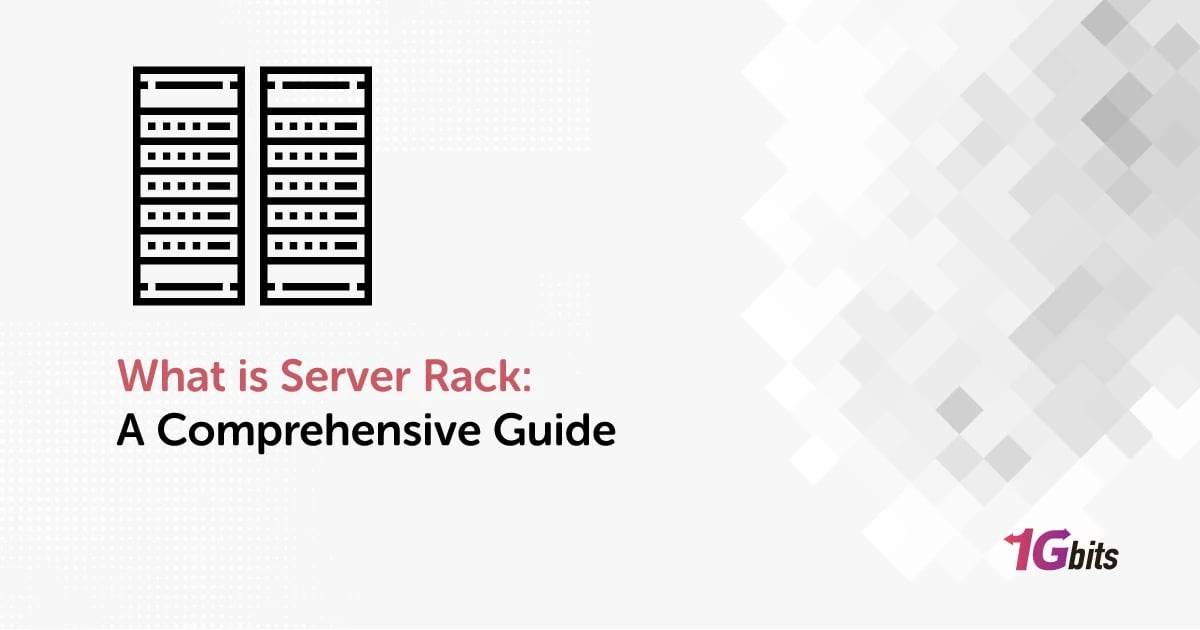In today's world of big data and the Internet of Things (IoT), technology is constantly evolving, leading to higher computing needs and changes in where IT systems are used. IT managers are on the lookout for reliable, flexible, and secure IT infrastructure that's also economical to run. That’s when learning what is server rack helps us.
When setting up their server racks, they prioritize products that offer protection and easy access to critical systems. These racks need to grow with their needs while staying budget-friendly. In this article, we want to talk about what is Server Rack in detail. So read along and get all the information you need.
What is a Server Rack?
A server rack is an important part of keeping IT systems organized and safe. It can be adjusted to fit different needs and setups, making it useful for various requirements. For those of you asking what is server rack, Server Racks have protective features to make sure everything stays secure. While they're usually found in big data centers, they can also be used in smaller computer closets.
The 19-inch server rack is the standard size for mounting equipment, especially for computer servers. Its design allows for neat hardware setups, saving space on the floor or shelves. Choosing a 19-inch server rack can be cheaper for setups with fewer servers because it costs less upfront.
The things you put on the rack are called rack-mounted or rackmount devices. They're attached to the rack by screwing or clipping their front panels in place securely.
Server Rack Cabinet
Now let’s see what is Server Rack Cabinet. A server rack cabinet functions similarly to a standard rack by housing IT equipment, but it usually comes with enclosure features. This includes doors at the front and rear, as well as walls on each side.
Enclosed racks are preferred by many for several reasons. Firstly, they provide additional security, protecting against theft or unintended damage. Secondly, controlling airflow can be simpler when both sides are covered, although this can also be achieved with side panels on an open frame rack. Lastly, if the rack will be placed in a more visible area, cabinets might offer better aesthetics.
What is Rack in Networking
You have a general understanding of what is server rack by now. Now let’s see what role it plays in networking.
A network rack, sometimes called a network equipment rack or cabinet, is a special kind of rack or cabinet made to store and arrange networking equipment and related hardware. These racks are found in places like data centers, server rooms, network closets, or telecommunications facilities. So if you still ask what is server rack data center, they're made to keep networking components like switches, routers, patch panels, modems, and other devices organized and secure.
What is a Rack-Mounted Server?
For those of you asking what is rack mount server, a rack-mounted server is a specialized computer designed specifically for use as a server and intended to be installed within a framework known as a rack. This framework contains multiple mounting slots referred to as bays, with each bay designed to securely hold a hardware unit in place using screws.
So what is the difference between rack and tower server? Unlike tower servers, which are housed within upright standalone cabinets, rack servers feature a low-profile enclosure that allows them to be neatly integrated into the rack system alongside other server components.
If you’re interested to know more about servers, check our article on What Is a Server?
Server rack components
Now that you know what is server rack, let’s get familiar with its components. Server rack components are the essential parts that make up the core configuration of a server rack. These elements include:
Structural frame: This serves as the foundation of the server rack, providing support and stability for all the network components. Factors like height, depth, and weight capacity must be considered when choosing a frame.
Server units: These are the main computing devices responsible for processing and storing data. Ensuring there's enough space and airflow around the servers is crucial.
Power distribution units (PDUs): A lot of people ask what is PDU in server rack. These units supply electrical power to servers and other equipment. Choosing PDUs with enough capacity and redundancy is vital for uninterrupted power supply.
Cooling systems: Efficient cooling, like fans or air conditioning, is necessary to prevent overheating and hardware failures.
Network switches: These facilitate communication within the rack and connect it to the broader network infrastructure, aligning with data transfer requirements.
Cable management systems: Proper cable management, with solutions like cable managers, ensures organized and accessible network cables.
Mounting hardware: Rails and hardware securely install equipment within the rack, ensuring stability and safety.
Security features: Lockable doors, access control systems, and surveillance cameras safeguard the rack from unauthorized access and threats.
Environmental monitoring systems: These track conditions like temperature and humidity, providing real-time data and alerts for prompt action.
Uninterruptible power supply (UPS): UPS units provide backup power during outages, ensuring continuity of operations.
KVM switches (keyboard, video, mouse): These allow the management of multiple servers from a single set of peripherals, enhancing efficiency in multi-server environments.
Server Rack Size, Depth, Rack Unit (U)
There are some concepts that you need to be familiar with if you want to know what is server rack. Home server racks come in various sizes, typically measured in height units (U). The most common size for mounting equipment is the 19-inch server rack, providing standardized dimensions for compatibility with server hardware. Depth refers to the distance from the front to the rear of the rack, accommodating the depth of equipment.
So what is U in server rack exactly? Rack Unit (U) refers to the vertical space within the rack, with each U equaling 1.75 inches. This measurement is crucial for determining the amount of space needed to accommodate servers and other rack-mounted devices effectively.
Types of server racks
Server racks come in different types, each with its style and purpose. Now that you know what is server rack, take a quick look at some common ones:
1. Server Rack Enclosure:
-
Fully enclosed with doors and side panels for extra security.
-
Great for places like data centers where security is important.
-
Key Features: Secure, Comes pre-assembled
2. Open-Frame Rack:
-
Simple rack for mounting IT gear in secure spots.
-
Easy to access equipment and cables, with good airflow.
-
Key Features: Easy Access, Affordable
Wall-Mounted Rack:
-
Compact and secure, attach directly to walls.
-
Perfect for tight spaces like network closets or classrooms.
-
Key Features: Secure, Saves Space
Low-Profile Rack:
-
Smaller than regular racks, ideal for cramped places.
-
Good for places like stores, offices, or hospitals.
-
Key Features: Small, Secure
Industrial-Grade Rack:
-
Made for specific equipment or tough environments like factories.
-
Provides safe and sealed housing.
-
Key Features: Sealed, Secure
Portable Rack:
-
Has wheels for easy moving.
-
Handy for moving gear between places.
-
Key Features: Mobile, Strong
Vertical-Mount Rack:
-
Designed for really tight spots like small offices or closets.
-
Mounts vertically on the wall to save space.
-
Key Features: Shallow Depth
Sound-Proof Server Rack:
-
Designed to make IT gear quieter.
-
Often used in places where noise is a problem, like offices or studios.
-
Key Features: Quiet
For more information about different types of servers, check our article on this topic.
What is Server Rack Used for?
Server racks are important parts of IT systems, helping to store and organize equipment effectively. They come in different types and styles to fit various needs and settings. Now that you know what is server rack, let's explore the different kinds of server racks and what is a rack server used for.
1. Open-Frame Racks
-
Labs: Open-frame racks are a popular choice for labs and test environments, offering a low-cost solution to hold equipment.
-
Data Centers: They are used in data centers where servers and network equipment are housed in secure cages.
-
Network Closets: Ideal for secure network closets where quick access to equipment is needed for troubleshooting and maintenance.
-
Audio/Visual Equipment: Sometimes used to house audio/visual equipment, especially when devices are frequently connected and disconnected.
2. Cabinet Racks (Rack Enclosures)
-
Data Centers: Commonly used in data centers to house servers and network equipment, providing better security and protection.
-
Financial or Government Facilities: Found in banks, financial services companies, and government offices where an enhanced level of security is needed.
-
Co-Location Facilities: Used in facilities where multiple customers share space, providing security and privacy for each company's equipment.
-
Remote Locations: Sometimes used in remote, non-IT spaces where equipment needs protection and secure enclosure.
3. Wall-Mounted Racks
-
Small Offices: As home server racks, they’re a great option for small offices or home offices where space is limited.
-
Retail Stores: Ideal for retail stores where space is limited but equipment needs to be secure.
-
Classrooms: Used in classrooms or training rooms to support a small number of devices.
-
Wiring Closets: Often found in network closets or utility rooms to house network equipment.
4. Mobile Racks
-
Trade Shows: Often used for trade shows and exhibitions where equipment needs to be transported and set up quickly.
-
Disaster Recovery: Used in disaster recovery scenarios where equipment needs quick transportation to restore critical IT services.
-
Military Operations: Sometimes used in military operations for quick setup in remote locations.
-
Film Production: Used in film production where equipment needs to be transported to different locations on set.
5. Specialty Server Racks
-
Outdoor Environments: Designed to withstand exposure to elements and used in applications such as telecommunications and surveillance.
-
Hazardous Environments: Intrinsically safe racks used in environments like chemical plants and refineries.
-
Audio/Visual Equipment: Used to house audio/visual equipment such as amplifiers and video distribution systems.
-
Medical Equipment: Used to house medical equipment like imaging systems and patient monitors.
Rack Server vs. Blade Server System
A lot of users ask what is blade server and rack server. A blade server is a compact computing device used to manage and distribute data across a network of computers and systems. Its key feature is rapid and easy scalability, with power and cooling systems integrated into its enclosure.
It typically includes input-output ports and around four connections for devices, eliminating the need for excessive cabling within the server rack when adding new devices. Blade servers excel in environments where maximizing computing power is essential.
When you’re exploring what is rack server vs blade server, consideration must be given to their usage location, as they consume less power and generate less heat compared to rack servers. Multiple blades are usually housed closely together within a chassis, requiring fan-based cooling.
In contrast, rack servers are suited for companies utilizing infrastructure housed in standard-sized enclosures. For those of you still asking what is Server Rack, these servers are securely mounted onto rack surfaces and can be mechanically secured within confined spaces. However, managing network cables requires skill to prevent clutter and maintain organization.









